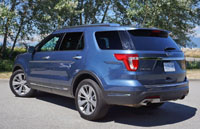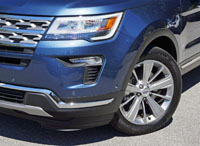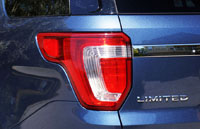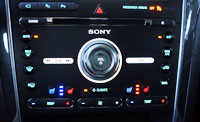
If you’re a fan of Ford’s Explorer, particularly the outgoing version that’s currently being replaced by an entirely new 2020 model, it’s time to do something about it. The unashamedly Range Rover-esque fifth-generation model that launched in 2010 for the 2011 model year, is still a viable alternative to more modern machines, if not the hippest seven-seater on the block.
Yes, this 2019 Explorer is well beyond its due date. In fact, its Ford D4 platform actually harks back to the 2004 Five Hundred/Taurus family sedan and 2007 Freestyle/Taurus X crossover SUV, and that D4 architecture was pulled from underneath a 1999 Volvo S80, which arrived the year before. Other D4-based models included some US-exclusive Mercurys, Lincoln’s MKS and MKT, plus Ford’s own Flex.
Even though this 2019 Explorer is hardly a spring chicken, it remains particularly good looking and reasonably up-to-date inside. Ford has modified its styling over the past decade, the more recent examples utilizing a greater amount of Ford DNA than earlier versions, therefore eschewing its much maligned Range Rover copycat persona. I really like the look of my tester’s Limited trim, as it’s chrome-adorned outer design boasts big 20-inch alloy wheels and a number of other styling upgrades, leaving a clean and uncluttered appearance that isn’t at all overdone.

Thanks to the numerous styling updates, improved powertrains, and updated infotainment systems that have kept the Explorer fairly fresh and mostly modern, each week that I’ve spent with one reminds me why it’s so amazingly popular. Canadians consistently push this three-row Ford up to third or fourth place in its mid-size SUV category, and number one if we’re talking three-row rivals, yet in spite of looking fine, anteing up plenty of performance, and delivering the types of features those buying into this segment expect, it’s more than starting to show its age when it comes to rubberized soft-touch composites and harder plastics inside.
The 2019 Explorer I recently drove looks identical to the mildly refreshed 2018 model, which was actually a subtle styling upgrade of the more wholesale 2016 mid-cycle makeover. Ford redid the alloy wheels as well as upgraded some of its features since then, but it’s more or less the same SUV under the sheet metal.
A trio of powerplants is up for grabs, beginning with the Dearborn, Michigan-based brand’s standard, and this model’s as-tested 2.3-litre Ecoboost four-cylinder that puts out a generous 280 horsepower and 310 lb-ft of torque. This engine can be substituted with a 3.5-litre Ti-VCT V6 that makes 10 horsepower more at 290, yet only 255 lb-ft of torque for an extra $1,000, with the advantage of more towing capability, which improves from 2,000 pounds in standard trim or 3,000 lbs maximum (907 or 1,360 kg), depending on whether or not its Class II tow package has been added, to 2,000 or 5,000 lbs (907 or 2,268 kg), the latter number reflecting the Explorer V6 model’s Class III trailering upgrade. These are identical trailering ratings given to the top-tier turbocharged 3.5-litre Ecoboost V6 that transforms this friendly workhorse into a rip-snorting thoroughbred thanks to 365 horsepower and 350 lb-ft of torque.

My test model was outfitted in its second-rung Limited grade, which starts at $46,034 instead of the base XLT’s $39,448 window sticker. Yes, that means Ford has dropped its front-wheel drive base model for 2019, along with its more reachable $34,899 price point. The XLT and Limited use the first two engines noted a moment ago, whereas the $49,683 Sport and $55,379 Platinum models only offer the more potent turbo-V6 (make sure to check out all the 2019 Ford Explorer pricing details right here at CarCostCanada, including trims, packages and individual options, plus available rebates and dealer invoice pricing that could save you thousands).
I was glad that Ford provided its base powertrain in my tester, because this four-cylinder engine combines good performance with great economy, the latter rating being 13.1 L/100km city, 9.2 highway and 11.4 combined compared to 14.5 city, 10.6 highway and 12.7 combined for the mid-grade V6. At least the top-line V6 Ecoboost engine provides plenty of get-up-and-go in lieu of its near V8-like fuel-efficiency of 15.2 L/100km in the city, 10.9 on the highway and 13.2 combined, but I’m still glad I was refueling the Ecoboost turbo-four. Also, you’re required to top up both Ecoboost engines with 93-octane premium-grade gas in order to achieve those just-noted numbers, but not with the mid-range V6, therefore actual running costs between the base turbo-four and second-rung V6 engines are likely very similar.
Before you start comparing the Explorer’s base fuel economy with its challengers you’ll need to factor in that this SUV now comes standard with Ford’s Intelligent 4WD, not front-wheel drive like it used to in Canada and still does in the U.S., like most competitors continue to do.

Together with standard 4WD, all Explorers include Ford’s Range Rover-style Terrain System too, which is capable of managing all kinds of on- and off-road conditions. All that’s required is a twist of its console-mounted dial, and while it’s not a go-anywhere 4×4 like Ford’s own full-size Expedition or the upcoming Bronco, the Explorer is still very capable over light and even medium duty trails when using its Snow, Gravel, Grass Mode, Sand Mode, or Mud, Rut Mode selections, made even better via standard Hill Descent Control and the usual traction and stability control systems, while it’s best left in default Normal Mode the rest of the time.
Like a true off-road capable SUV, the Explorer sits taller than most crossover SUVs in its mid-size class, providing a more truck-like experience, but as noted before it is based on a conventional unibody platform. This means that its body structure stays tight and rigid, an easily noticeable trait that’s much appreciated when dealing with bumps, potholes and other annoyances. This has much to do with the amount of fine-tuning done by Ford’s engineering team over the past decade, because the Freestyle I first tested a dozen years ago never felt as composed. Both sit atop a well-sorted independent MacPherson strut front suspension and multi-link rear design, plus a 32-mm front stabilizer bar and 22-mm one in back, all of which provides an impressive ride quality and handling balance.

My as-tested Explorer Limited also had significant mass to contend with, its curb weight being a significant 2,066 kilograms (4,556 pounds) even with its lightest 2.3-litre turbo-four under-hood, but the aforementioned horsepower and torque numbers made sure it still delivered strong acceleration off the line, up to highway speeds and beyond, while its six-speed automatic gearbox (the only transmission offered) matches the engine well. The more remedial transmission should provide better reliability than all the competitive eight-, nine- and 10-speed autoboxes too, the latter count corresponding with the number of forward gears offered in the new 2020 Explorer, incidentally. I found the 2019 Explorer’s six-speed automatic swapped cogs with a steady smoothness and plenty of positive action when pushing hard, the latter enhanced with a thumb rocker switch on the shift knob when wanting to engage manual mode, so I would have zero issues with four less gears if it proved to be a more dependable transmission long-term.
Speed is one thing, but in the family-hauling SUV world comfort is king. Fortunately the Explorer provides comfort in spades, not to mention room to spare. It can manage up to seven occupants in standard trim or six when outfitted with second-row captain’s chairs. My tester’s standard configuration allowed for three-abreast seating across the second row without discomfort, the outboard positions benefiting from two-way heat for warming rear derrieres during the cold winter months. Two buttons on the backside of the front centre console turn them on or off, these placed beside a manual rear temperature control panel that also houses dual USB charging ports, plus a three-prong 110-volt household-style AC charger.

For accessing the third row, each 60/40-split side of the second row can be flipped forward and out of the way, allowing for a lot of access space, while those relegated to the very back should definitely be comfortable unless they’re taller than average. My five-foot-eight medium-build body fit in nicely, with more than enough room in each direction.
The 50/50 split-folding rearmost seats can be dropped down into a deep luggage well when not in use, by available power controls on the cargo wall no less. They stow away similarly to how they would in a high-end minivan, but you’ll need to walk around to the side doors in order to lay the second-row seats flat. When done you’ll end up with a lot of room to carry life’s belongings, the Explorer’s available cargo volume expanding from 595 litres (21.0 cubic feet) behind the third row, or 1,240 litres (43.9 cubic feet) aft of the second row, to a total of 2,313 litres (81.7 cubic feet) behind the first row. That’s an impressive load when compared to its three-row challengers.
Back in the driver’s seat, the Explorer Limited’s main chair is 10-way powered and should therefore be comfortable for most shapes and sizes, even including four-way powered lumbar support for locating the ideal position to add pressure on the small of the back. The power-adjustable steering column provides loads of reach too, which made it easy to set up a driving position that optimized both comfort and control, while all buttons, knobs and dials on the instrument panel were easy enough to reach.

That included the centre touchscreen, which includes Ford’s superb Sync 3 infotainment interface. Granted, it’s not as modern as more recently updated models in this class, the new Explorer included, but its white and black (and sometimes wine) on light blue graphics remain fresh and good looking, while the system continues to be relatively quick to respond to inputs, if not providing the best resolution currently available. Its matte display minimizes fingerprints, plus it is bright and easy to read, and therefore better than some competitive displays that wash out in sunlight. For example, a 2019 Toyota Highlander’s centre display nearly impossible to see in due to glare (a model not yet upgraded with Toyota’s newest and much improved Entune infotainment system), and it was worse when donning my polarized sunglasses. In the Explorer this is not an issue.
All of the Explorer’s switchgear is on par with others in its segment, some even better. The rotating audio knob, for instance, is edged in knurled metal that adds a premium feel and look. The cabin’s woodgrain inlays are really dense and authentic feeling too, these running across the instrument panel as well as each door, while I really like the way Ford surrounded the wood in satin-finish aluminum, the two metal trim sections meeting where the dash ends and door panel begins. It would’ve looked much better if they aligned more evenly, the doors obviously not hung properly during assembly (see photos 28 and 29 in the gallery for a clear view), but Ford should get bonus points for the quality of these trim pieces and the Explorer’s overall good interior design (I’m guessing you can ask your local dealer to rehang the doors if the Explorer you’re buying suffers from the same problem).

The just-noted wood and metal inlays come standard, while base XLT features not yet mentioned include LED signature lighting enhancing the otherwise auto LED low-beam headlights, plus LED fog lights, LED tail lamps, 18-inch alloys on 245/60 all-seasons, silver roof rails, Ford’s Easy Fuel capless fuel filler, remote start, proximity access with pushbutton start/stop, Ford’s SecuriCode keypad on the B-pillar, MyKey, forward and reverse parking sonar, a leather-wrapped multi-function steering wheel, a leather-wrapped shift knob, an eight-way power-adjustable driver’s seat, heatable front seats, an auto-dimming centre mirror, Ford’s Sync 3 infotainment touchscreen with a backup camera, a seven-speaker AM/FM/MP3 audio system with satellite radio, FordPass Connect with a Wi-Fi Hotspot, a media hub that includes a smart-charging USB and four 12-volt power points (two in the first row, one in the second row, and one in the cargo area), filtered two-zone auto HVAC, blindspot monitoring with rear cross-traffic alert, and plenty more.
The Explorer’s rigid body shell is standard too, plus enough safety gear to achieve an NHTSA 5-star crash rating, while Ford also makes a new (last year) $1,000 Safe and Smart Package available that adds rain-sensing windshield wipers, auto high beams, dynamic cruise control, forward collision warning with brake support, and lane-keeping assist.

That Safe and Smart Package was added to my Limited tester, which otherwise gets more standard chrome exterior trim, unique 20-inch alloys riding on 255/50 tires, power-folding outside mirrors with integrated LED turn indicators, ambient interior lights, a heated steering wheel, a power-adjustable tilt and telescopic steering column, a universal garage door opener, perforated leather upholstery with three-way cooling and memory (that also memorizes mirror and steering column settings), a 10-way power-adjustable front passenger seat, a 180-degree split-view front parking camera, a voice-activated navigation system that includes SiriusXM Traffic and Travel Link, a hands-free foot-activated power liftgate, an excellent sounding 12-speaker Sony audio system, the 110-volt AC power outlet, heatable second-row seats, and power-folding third row I noted earlier, plus Ford included a $1,750 two-pane powered panoramic sunroof above, all of which kept my Explorer tester under $50k, including destination fees.
Ford offers a number of additional options and packages too, such as a $1,500 XLT Desert Copper Package that includes unique 20-inch alloy wheels, chrome side mirrors, and black/copper leather upholstery to base XLT trim; and the $1,600 XLT Sport Appearance Package that features “EXPLORER” block letters on the hood, special Magnetic Metallic-painted (black) 20-inch alloys, exterior accents painted in Magnetic Metallic, black roof rails, “EXPLORER” enhanced front floor mats, upgraded door panels highlighted with Fire Orange contrast stitching, black leather upholstery with perforated Miko inserts, Foxfire scrim and the same Fire Orange contrast stitching, plus more.

Ford could have upgraded my Limited tester with a $2,900 301A package as well, which features the Safe and Smart Package as well as a set of Multicontour front seats with Active Motion massage, active park assist, and inflatable rear outboard safety belts.
As for the previously noted Sport trim line, other than the much more potent turbo-V6 it receives cool looking glossy black exterior trim most everywhere chrome was before, including the mirror housings and outer door handles, while also adding a special blackout treatment to the headlights and tail lamps, while also including its own set of blackened 20-inch rims, upgrades the cabin including perforated leather upholstery with red stitching, plus an improved Sony audio system with Clear Phase and Live Acoustics, while all of the Limited trim’s features are included too, plus the Safe and Smart Package.
Finally, top-line Platinum trim gets everything already noted except for the Sport model’s black exterior trim and special interior details. Instead it features satin-chrome on the outside, plus a sporty quad of chromed tailpipes, resulting in the most Range Rover-like Explorer from an exterior design perspective. Nevertheless it’s a very attractive family hauler, complete with power-adjustable pedals, a standard twin-panel moonroof, active park assist, and exclusive Ash Swirl wood inlays edged in real aluminum, plus Nirvana leather upholstery featuring micro-perforations and rich quilted side bolsters.

Platinum trim also includes the massaging Multicontour seats from the aforementioned 301A package, an upgraded gauge cluster, a leather-clad instrument panel and door uppers, additional leather covering the door and centre console armrests, a unique headliner, and active noise reduction.
The Platinum would have made for a more enjoyable week than my Limited test model for sure, but if I were purchasing the $6k difference would cause me some pause. Either way the Explorer still looks great, is really nice to drive, is good on fuel when outfitted with its turbo-four, comes loaded with luxury goodies, is ultra accommodating for passengers and cargo, and is nicely finished too (not including those misaligned trim pieces).
All said, the soon to be discontinued fifth-generation Explorer remains an excellent three-row crossover SUV that any price-sensitive buyer should consider now that dealers are ready to sharpen their pencils. Sure it’s going to look a bit old next to the all-new 2020 model, but it’s a tried and tested utility that should provide years of hassle-free service, and that’s a luxury that might make it an ideal choice.
Story credit: Trevor Hofmann
Photo credit: Karen Tuggay
